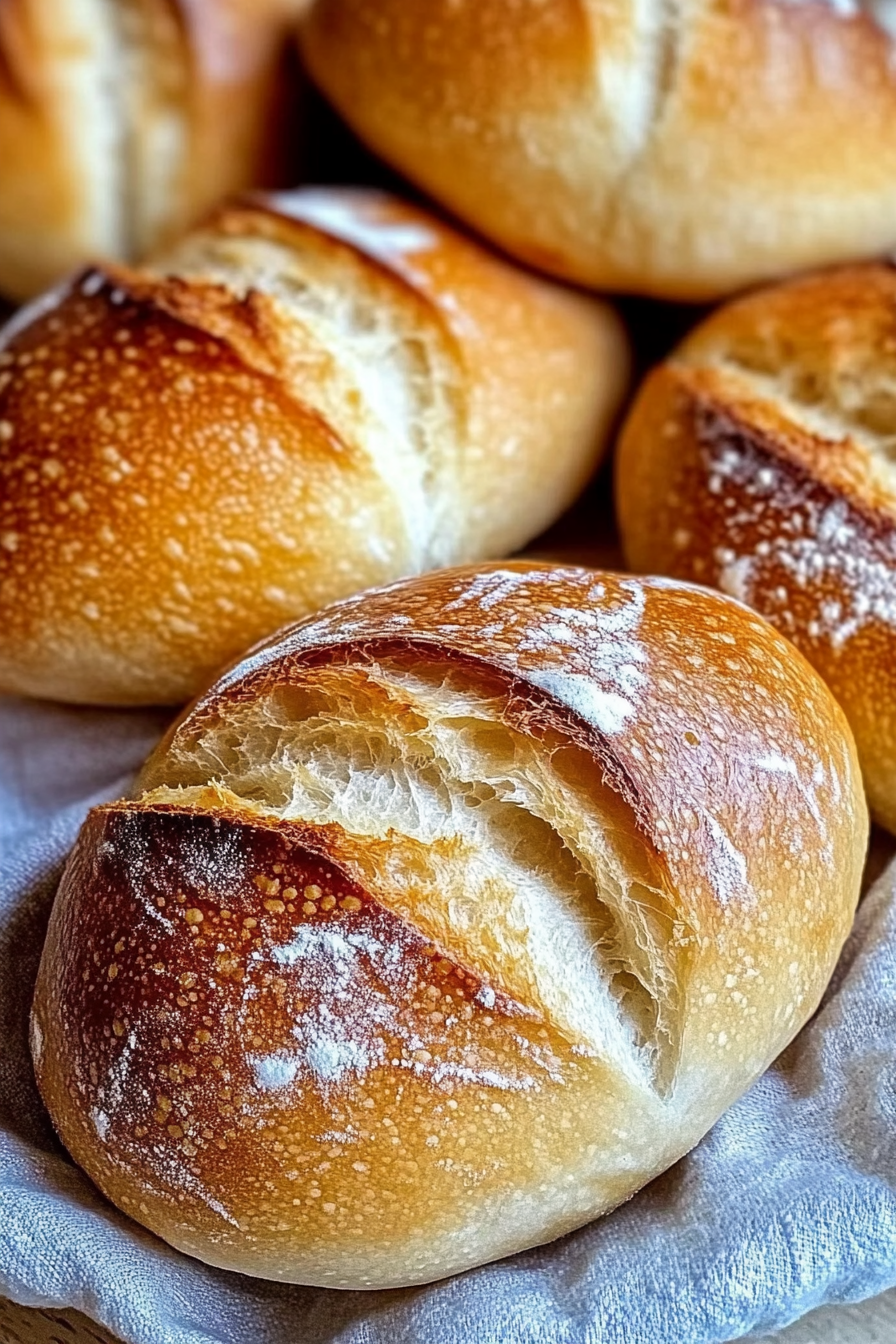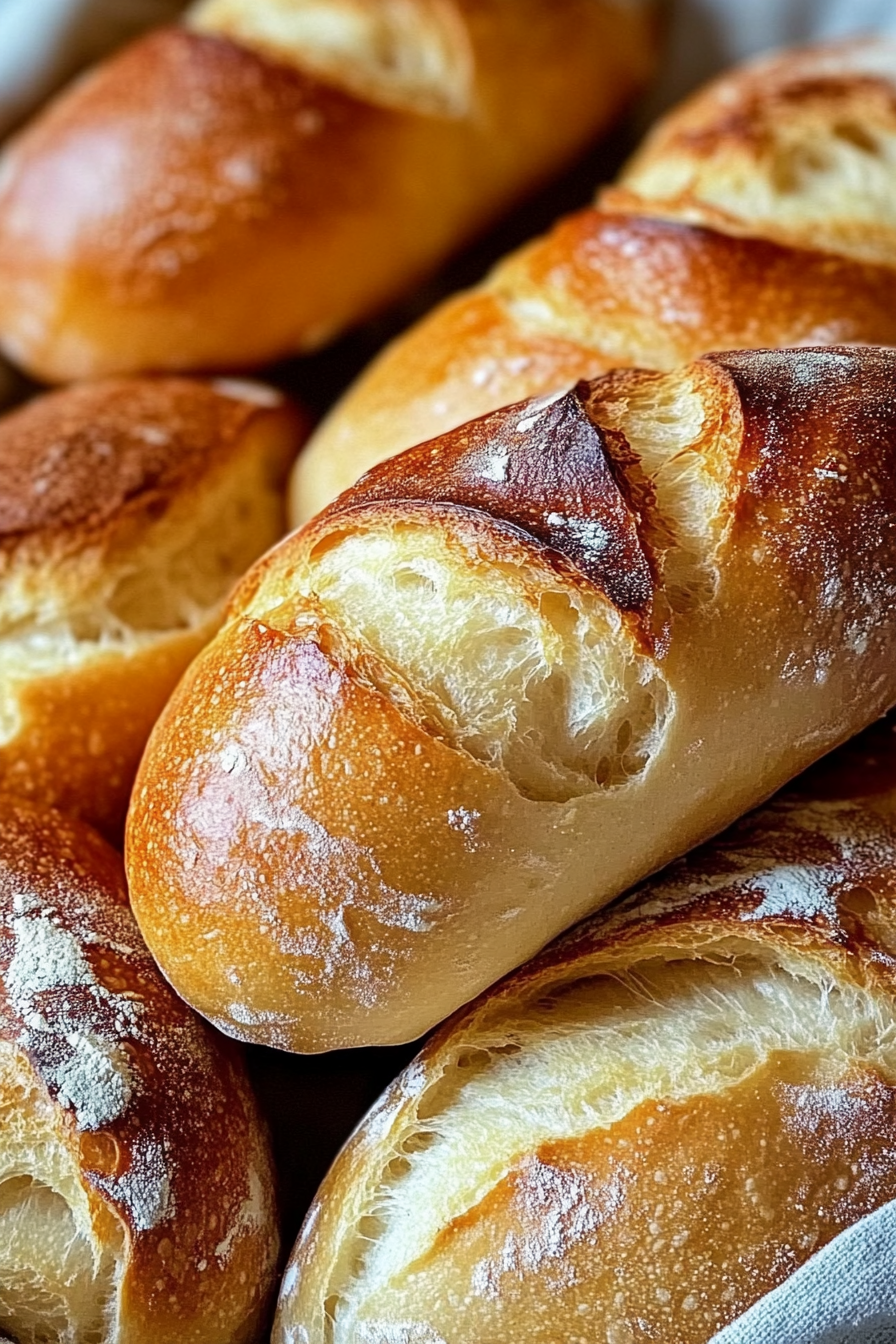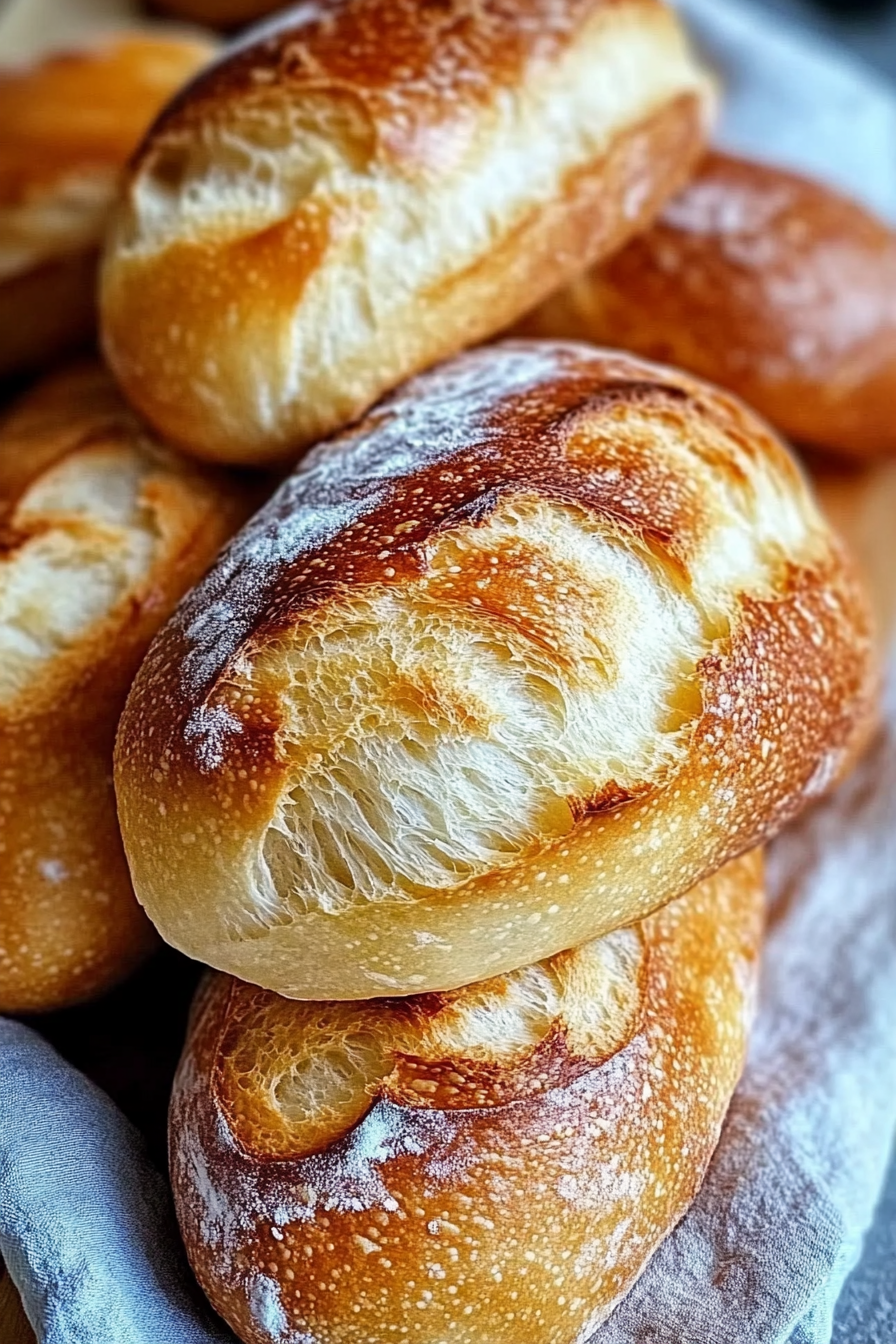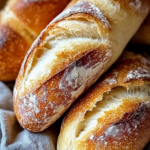Introduction to Crusty Chewy French Bread Rolls Artisan Perfection at Home
Crusty Chewy French Bread Rolls Artisan Perfection at Home offers a delightful culinary experience, perfect for those seeking artisan bread-making in their own kitchen. These rolls boast a crisp exterior with a soft, chewy interior, making them an ideal accompaniment for any meal. The recipe’s simplicity, using basic yet wholesome ingredients like flour, water, and yeast, ensures it’s accessible for home cooks while providing a healthier alternative free from excessive fats. As part of Valentina Recipes, this French bread roll guide invites you to embrace the joy of homemade baking, fostering rich moments around your dining table.
Benefits and Advantages of Crusty Chewy French Bread Rolls Artisan Perfection at Home
Creating Crusty Chewy French Bread Rolls Artisan Perfection at Home is not only a rewarding kitchen endeavor but also one that offers numerous benefits. Firstly, the ease of preparation makes it a highly approachable recipe for both novice and experienced bakers, encouraging an enjoyable cooking experience. Additionally, these bread rolls distinguish themselves with a healthier profile, given their low-fat content and absence of oils or buttery additions, catering to diet-conscious individuals. Furthermore, the long fermentation period enhances the rolls’ flavor profile while achieving the perfect balance of crunch and chewiness, setting them apart as a gourmet home-baked delight.

Ingredients Overview
Essential Ingredients for Crusty Chewy French Bread Rolls Artisan Perfection at Home
Creating the perfect crusty and chewy French bread rolls at home begins with understanding the essential ingredients. These ingredients serve as the foundation for both the flavor and texture of the rolls:
- All-Purpose Flour: 4 cups – This main ingredient provides structure and the perfect level of gluten for a chewy texture.
- Water: 1 ½ cups, lukewarm – Hydrates the dough and assists in gluten formation, crucial for achieving that desirable chew.
- Active Dry Yeast: 2 teaspoons – The key to rise, which gives the rolls their light, airy interior.
- Salt: 2 teaspoons – Enhances overall flavor and strengthens the dough’s structure.
- Sugar: 1 tablespoon (optional) – While not always necessary, sugar can help yeast activity and add subtle sweetness.
The flour and water combination lays the groundwork for gluten development, while the yeast acts as a leavening agent to provide volume and airiness. Salt elevates the flavors of the rolls and aids in structural integrity. For those interested in a touch of sweetness, sugar is an optional additive.
Dietary Substitutions to Customize Your Crusty Chewy French Bread Rolls Artisan Perfection at Home
Every home cook needs to cater to different dietary needs or ingredient availability. Here are some practical substitutions to make your French bread rolls more accommodating:
- Gluten-Free Option: Substitute the all-purpose flour with a quality gluten-free flour blend to cater to gluten-sensitive individuals.
- Vegan Option: All ingredients are naturally vegan, so these rolls perfectly suit a plant-based diet as is.
- Low-Calorie Alternative: Maximize flavor with herbs like rosemary or thyme instead of using sugar, reducing overall calories.
These adjustments ensure you can prepare the Crusty Chewy French Bread Rolls Artisan Perfection at Home for audiences with varying dietary preferences. Those seeking more baking tips can find helpful guidance on the King Arthur Baking blog, which provides an excellent resource for further recipe adaptations.
How to Prepare the Perfect Crusty Chewy French Bread Rolls Artisan Perfection at Home: Step-by-Step Guide
Follow these comprehensive steps to create your own homemade crusty French bread rolls, which will delight family and friends alike:
First Step: Mix Ingredients
Combine flour, yeast, salt, and sugar in a large bowl. Gradually add lukewarm water while mixing until the dough starts coming together.
Second Step: Initial Kneading
Transfer the dough onto a floured surface. Knead for about 10 minutes until smooth and elastic. You can knead by hand or use a stand mixer with a dough hook attachment for ease.
Third Step: First Rise
Shape the dough into a ball and place it in a lightly greased bowl. Cover with a damp cloth and let it rise in a warm spot until it doubles in size, approximately 1-2 hours.
Fourth Step: Shaping Rolls
After the first rise, punch down the dough to release air. Divide it into equal parts and shape each into a tight ball by folding the edges underneath.
Fifth Step: Final Rise
Arrange the shaped rolls on a baking sheet lined with parchment paper. Cover with a cloth and let them rise again for about 30-45 minutes.
Sixth Step: Preheat Oven
Preheat your oven to 425°F while the rolls undergo their final rise. Place an oven-safe dish with water inside the oven to generate steam.
Seventh Step: Scoring and Baking
Before baking, score the tops of each roll with a sharp knife. Bake for 15-20 minutes until golden brown and sound hollow when tapped on the bottom.
Eighth Step: Cooling and Serving
Allow the rolls to cool on a wire rack for a few minutes. This helps the interior’s texture set perfectly before serving.
This straightforward process ensures delightful outcomes every time. If you’re looking to learn more about the science behind steam in bread baking, be sure to check out Serious Eats for deeper insights.

Mastering Crusty Chewy French Bread Rolls Artisan Perfection at Home: Advanced Tips and Variations
Creating crusty chewy French bread rolls with artisan perfection at home takes skill and a little bit of practice. However, with the right tips and variations, even beginners can achieve bakery-quality results. Here are some advanced tips to help you perfect your bread rolls:
Advanced Tips for Perfecting Your Bread Rolls
- Use High-Quality Ingredients: Opt for organic all-purpose flour for better flavor and consistency. The quality of your ingredients directly influences the taste and texture of your bread rolls.
- Pay Attention to Fermentation: Allow the dough to ferment slowly, either overnight in the fridge or for several hours at room temperature. This develops a deeper flavor and enhances the chewy texture that differentiates these rolls.
- Master the Folding Technique: Proper folding of the dough creates tension which contributes to the crusty exterior. Fold the dough over itself several times before shaping into rolls.
- Utilize Steam: To achieve that characteristic crispy crust, create steam in your oven. Place a pan of water at the bottom of the oven or spray water on the rolls before baking. Learn more about the role of steam from King Arthur Flour’s guide.
Delicious Variations to Try
One of the joys of homemade bread rolls is the ability to experiment with different flavors and styles. Here are a few variations you might consider:
- Herb-Infused Rolls: Incorporate fresh rosemary, thyme, or basil into the dough for a fragrant twist.
- Seed-Crusted Rolls: Roll the shaped dough in sesame seeds or poppy seeds before baking for a nutty flavor and added texture.
- Cheese Stuffed Rolls: For a cheesy delight, fold in grated cheddar or parmesan into the dough, or place a cube of cheese inside each roll before baking.
- Savory Additions: For something unique, add chopped olives, sun-dried tomatoes, or caramelized onions into the dough.
Experimenting with these variations not only enhances the flavors but also makes the baking process more enjoyable. With practice and creativity, you’ll confidently produce artisan-quality bread rolls that impress family and friends.
How to Store Crusty Chewy French Bread Rolls Artisan Perfection at Home: Best Practices
After baking your perfect crusty chewy French bread rolls, it’s essential to store them properly to maintain their delightful texture and flavor. Here are the best practices for keeping your bread rolls fresh:
Storing Fresh Bread Rolls
- Room Temperature Storage: Store rolls in a bread box or a paper bag at room temperature for up to two days. This method helps preserve the crustiness while preventing the rolls from becoming stale.
- Refrigeration: If you plan to keep the rolls for a longer period, wrap them in a slightly damp cloth and place them in a plastic bag before refrigerating. However, know that refrigeration can sometimes make them denser.
Freezing and Reheating Bread Rolls
- Freezing Tips: Once completely cooled, wrap each roll individually in plastic wrap and place them in airtight freezer bags. This prevents freezer burn and preserves their texture for up to three months.
- Proper Reheating: To reheat, thaw the rolls at room temperature and then reheat in a preheated oven at 350°F for 10-15 minutes until warmed through. Spray a little water on the rolls before reheating to help bring back crispiness.
To ensure the best texture and flavor, enjoy your bread rolls at their freshest, perhaps pairing them with a savory dish like a creamy potato soup or a delightful lasagna soup. Maintaining the quality of your rolls after baking enables you to enjoy them as if they’re freshly baked even days later.

Nutritional Value of Crusty Chewy French Bread Rolls Artisan Perfection at Home
Understanding the nutritional profile of these crusty and chewy French bread rolls is essential for those mindful of dietary intake. These rolls, known for their crispy exterior and soft interior, are crafted with simplicity and minimal ingredients, yet they pack a pleasing nutritional punch that complements a balanced diet.
Macronutrients Composition
- Calories: Each roll typically contains about 150-180 calories, depending on the size and specific ingredients used.
- Protein: A single roll provides approximately 5-7 grams of protein, contributing to daily protein intake.
- Fat: These rolls are low in fat, generally containing less than 1 gram per serving, making them an excellent choice for those on low-fat diets.
- Carbohydrates: With around 30-35 grams of carbohydrates per roll, they offer a reliable energy source, particularly beneficial for active individuals and students.
- Fiber: Roughly 1-2 grams of dietary fiber per roll aids digestion and promotes satiety.
These figures can vary with different recipes or variations of the bread rolls, ensuring flexibility for various dietary preferences. For a more diversified nutrition plan, explore additional salad recipes on Valentina Recipes which pair well with these homemade rolls.
Vitamins and Minerals
These artisan bread rolls offer a modest supply of essential vitamins and minerals:
- Iron: Supporting red blood cell production, iron is crucial for maintaining energy levels.
- B Vitamins: The use of enriched flour provides a good source of essential B vitamins like thiamin, riboflavin, niacin, and folate.
- Sodium: Typically containing 200-250 milligrams per roll, sodium levels can be adjusted to personal taste or dietary needs.
Exploring ingredients such as whole grain flour can enhance the mineral content further, offering higher fiber content and increased levels of zinc and magnesium.
Customization for Healthier Options
For diet-conscious individuals, using alternative flours like almond flour or gluten-free mixes can help tailor these rolls to specific dietary requirements. In addition, incorporating seeds or herbs into the dough not only diversifies flavor but also increases the nutrient density. For instance, adding flaxseeds can improve the omega-3 fatty acid content, making the rolls a heart-healthy choice.
Ultimately, crusty chewy French bread rolls offer a nutritional balance, fitting seamlessly into a variety of meal plans. Paired with heartier dishes, such as the Creamy Potato Soup from Valentina Recipes, these rolls can enrich any dining experience, catering to diverse palates and nutritional needs.
FAQs: Frequently Asked Questions About Crusty Chewy French Bread Rolls Artisan Perfection at Home
How do I store crusty French bread rolls to keep them fresh for a longer period?
To maintain the freshness of your crusty French bread rolls, it’s best to store them in a bread box or wrap them loosely in a cloth at room temperature for up to two days. Avoid plastic wrappings as they can trap moisture, making the crust soggy. For longer storage, consider freezing the rolls.
Can I make crusty French bread rolls ahead of time and freeze them for later use?
Yes, you can. After baking, let the rolls cool completely before placing them in airtight containers or freezer bags. For optimal quality, consume frozen rolls within one month. To enjoy, thaw the rolls at room temperature and warm them in the oven to restore their crispiness.
What temperature and baking time are best for achieving a crispy crust on French bread rolls?
Baking crusty French bread rolls at a high temperature of 400-425°F for approximately 15-20 minutes will help achieve the desired crispy crust. Introducing steam during the first few minutes of baking can enhance the crust texture, as discussed in this guide by King Arthur Flour.
How can I achieve a chewy interior and a crispy crust in my homemade French bread rolls?
The key to a chewy interior and crispy crust lies in the dough preparation and baking technique. Allowing the dough to ferment longer helps develop gluten, contributing to a chewy texture. Additionally, using steam during baking, as elaborated in this Serious Eats article, will aid in achieving the perfect crust.
Print
Crusty Chewy French Bread Rolls Artisan Perfection at Home: Perfectly Soft Inside
- Total Time: 3 hours 20 minutes
Description
🍞✨ Bring the bakery home with these crusty, chewy French bread rolls—golden on the outside, airy and soft inside, perfect for any meal! ✨🍞
🔥🥖 With simple ingredients and a slow rise for deep flavor, these rolls are a must-try for homemade bread lovers—crispy, warm, and utterly delicious! 🥖🔥
Ingredients
Bread flour
Water
Active dry yeast or instant yeast
Salt
Sugar (optional)
Egg wash (optional, for shine)
Additional water (for steam in oven)
Herbs or seeds (optional, for variation)
Instructions
1. Mix warm water, yeast, and a pinch of sugar in a bowl and let it sit for 5-10 minutes until foamy.
2. In a large mixing bowl, combine flour and salt, then add the yeast mixture.
3. Knead the dough by hand or with a stand mixer for about 8-10 minutes until smooth and elastic.
4. Cover the dough with a damp towel and let it rise for 1.5 to 2 hours until doubled in size.
5. Punch down the dough and transfer it to a floured surface.
6. Divide the dough into equal-sized portions and shape each into a tight ball by folding the edges underneath.
7. Place the shaped rolls on a baking sheet lined with parchment paper, leaving space between them.
8. Cover loosely with plastic wrap or a towel and let them rise for another 30-45 minutes.
9. Preheat the oven to 425°F (220°C) and place a pan of hot water on the bottom rack for steam.
10. Score the tops of the rolls with a sharp knife or lame for expansion.
11. Lightly brush with egg wash for shine or spray with water for a crustier texture.
12. Bake for 15-20 minutes until golden brown and crisp on the outside.
13. Remove from the oven and let the rolls cool slightly on a wire rack.
14. Serve warm or at room temperature as dinner rolls, sandwich rolls, or for dipping in soups.
15. Store leftovers in an airtight container or freeze for later use.
Notes
Let the dough rise slowly in the refrigerator overnight to build a deeper flavor and better texture.
Spray the oven walls with water or place a pan of hot water inside while baking to achieve a crispier crust.
Score the rolls with a sharp knife right before baking to allow for controlled expansion and a beautiful artisanal look.
- Prep Time: 180
- Cook Time: 20
- Category: Bread
- Method: Baking
- Cuisine: French

